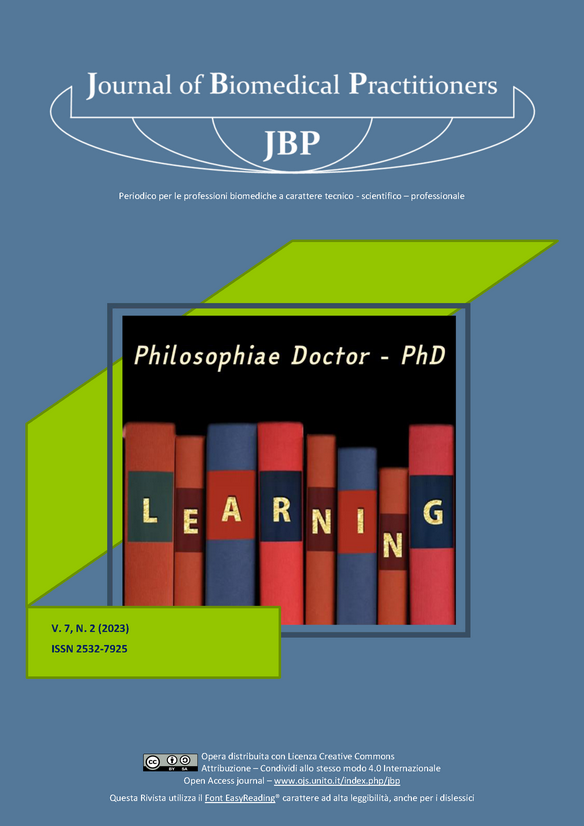Nurses and Medical Physics: an observational study on the knowledge of the physical basis of Medical Devices.
Contenuto principale dell'articolo
Abstract
BACKGROUND
In recent decades, nursing is increasingly considered as a scientific discipline. Subjects such as Medical Physics, Statistics, and scientific method are important in professional training. In particular, understanding the physical basis of medical devices, their elaborated parameters, the methods and how information reaches the nurse allows a more informed practice.
OBJECTIVES
Primary objective. Investigate nurses' knowledge of the physical basis of the used medical device.
Secondary objective. Investigate whether the qualification type (professional school, diploma, or degree), the years since the end of the study, age, or Italian regional origin can influence this knowledge.
METHODOLOGY
An observational study was conducted using an anonymous online questionnaire developed ad hoc and addressed to nurses working in Italy. The responses were analyzed with chi-square tests divided by type of studies, years since the end of the study, and Italian region of origin.
RESULTS
More than half of the interviewees were unable to give the correct answer on the functioning of the sphygmomanometer (54.3%) and phonendoscope (53.0%). ECG and oximeter are the most understood instruments (79.0 and 67.9% correct answers respectively). 45.7% of interviewed do not remember that one cubic centimeter (CC) and one milliliter (ml) have a conversion factor of 1. No differences were found by qualification type, years since the end of the study (considering both the median and a limit of 5 years for new graduates), age, and Italian region of work (p>0.05).
DISCUSSION and CONCLUSIONS
Knowledge of the physical basis of the used medical devices does not seem to degrade over time. In the light of this, it would be more useful to consolidate these foundations in the three-year degree course of Nursing, rather than investing in post qualification courses. Such training, however, would be desirable to allow current professionals to fill the gaps emerged in this study.
Downloads
Dettagli dell'articolo
Gli autori mantengono i diritti sulla loro opera e cedono alla rivista il diritto di prima pubblicazione dell'opera, contemporaneamente licenziata sotto una Licenza Creative Commons - Attribuzione che permette ad altri di condividere l'opera indicando la paternità intellettuale e la prima pubblicazione su questa rivista.
Riferimenti bibliografici
[2] ‘Cronistoria e Normative di riferimento’, OPI Novara VCO. Accessed: Aug. 22, 2023. [Online]. Available: https://www.opinovaravco.it/cronistoria-e-normative-di-riferimento/
[3] ‘Decreto Interministeriale del 2 aprile 2001 - Atti Ministeriali MIUR’. Accessed: Aug. 22, 2023. [Online]. Avai-lable: http://attiministeriali.miur.it/anno-2001/aprile/di-02042001.aspx
[4] ‘Decreto Ministeriale del 9 luglio 2004 - Atti Ministeriali MIUR’. Accessed: Aug. 22, 2023. [Online]. Available: http://attiministeriali.miur.it/anno-2004/luglio/dm-09072004.aspx
[5] C. Green and L. John, ‘Should nursing be considered a STEM profession?’, Nurs Forum, vol. 55, no. 2, pp. 205–210, Apr. 2020, doi: 10.1111/nuf.12417.
[6] J. Profetto-McGrath, ‘Critical Thinking and Evidence-Based Practice’, Journal of Professional Nursing, vol. 21, no. 6, pp. 364–371, Nov. 2005, doi: 10.1016/j.profnurs.2005.10.002.
[7] S. M. Hunter Revell and M. K. McCurry, ‘Effective pedagogies for teaching math to nursing students: a literature review’, Nurse Educ Today, vol. 33, no. 11, pp. 1352–1356, Nov. 2013, doi: 10.1016/j.nedt.2012.07.014.
[8] C.-Y. Chang, H.-J. Jen, and W.-S. Su, ‘Trends in artificial intelligence in nursing: Impacts on nursing manage-ment’, J Nurs Manag, vol. 30, no. 8, pp. 3644–3653, Nov. 2022, doi: 10.1111/jonm.13770.
[9] E. S. Mousavinasab, S. Rostam Niakan Kalhori, N. Zarifsanaiey, M. Rakhshan, and M. Ghazisaeedi, ‘Nursing pro-cess education: A review of methods and characteristics’, Nurse Educ Pract, vol. 48, p. 102886, Oct. 2020, doi: 10.1016/j.nepr.2020.102886.
[10] E. M. Davis et al., ‘Difficult intravenous access in the emergency department: Performance and impact of ultra-sound-guided IV insertion performed by nurses’, Am J Emerg Med, vol. 46, pp. 539–544, Aug. 2021, doi: 10.1016/j.ajem.2020.11.013.
[11] B. Galen, S. Baron, S. Young, A. Hall, L. Berger-Spivack, and W. Southern, ‘Reducing peripherally inserted cen-tral catheters and midline catheters by training nurses in ultrasound-guided peripheral intravenous catheter pla-cement’, BMJ Qual Saf, vol. 29, no. 3, pp. 245–249, Mar. 2020, doi: 10.1136/bmjqs-2019-009923.
[12] C. dei deputati, ‘PNRR: le risorse per la Missione Salute (M6)’, Documentazione parlamentare. Accessed: Aug. 29, 2023. [Online]. Available: https://temi.camera.it/leg18/post/OCD15_14428/pnrr-risorse-missione-salute-m6.html
[13] T. T. Meum, T. B. Koch, H. S. Briseid, G. L. Vabo, and J. Rabben, ‘Perceptions of digital technology in nursing education: A qualitative study’, Nurse Educ Pract, vol. 54, p. 103136, Jul. 2021, doi: 10.1016/j.nepr.2021.103136.
[14] L. Hirvonen et al., ‘Nurses’ knowledge of radiation protection: A cross-sectional study’, Radiography, vol. 25, no. 4, pp. e108–e112, Nov. 2019, doi: 10.1016/j.radi.2019.04.011.
[15] ‘Attività e competenze | Atlante Delle Professioni’. Accessed: Aug. 29, 2023. [Online]. Available: https://www.atlantedelleprofessioni.it/professioni/infermiere-infermiera/Attivita-e-competenze
[16] ‘CONOSCO GLI STRUMENTI CHE USO?’, Google Docs. Accessed: Jul. 05, 2023. [Online]. Available: https://docs.google.com/forms/d/e/1FAIpQLSduheWHctHCy1M2d0MFEjy_vO9HRX8b5K2zROEfCQYNfwga_Q/viewform?usp=drive_web&usp=embed_facebook
[17] E. Vitale et al., ‘Transcultural health: attitudes, perceptions, knowledge of Italian nurses. An observational stu-dy’, Acta Biomed, vol. 93, no. 5, p. e2022306, Oct. 2022, doi: 10.23750/abm.v93i5.13593.
[18] E. Vitale et al., ‘Communicating bad news: attitudes and modes of communication of the health professions’, G Ital Med Lav Ergon, vol. 44, no. 3, pp. 376–384, Sep. 2022.
[19] D. Garrison, D. Morgan, and J. Johnson, ‘Thriving in chaos: Educating the nurse leaders of the future’, Nursing leadership forum, vol. 9, no. 1, Fall 2004, Accessed: Jul. 05, 2023. [Online]. Available: https://pubmed.ncbi.nlm.nih.gov/15682586/
[20] K. Jokiniemi, A. Pietilä, and S. Mikkonen, ‘Construct validity of clinical nurse specialist core competency scale: An exploratory factor analysis’, Journal of clinical nursing, vol. 30, no. 13–14, Jul. 2021, doi: 10.1111/jocn.15587.
[21] M. Bianchi et al., ‘A review of the role of nurse leadership in promoting and sustaining evidence-based practice’, J Nurs Manag, vol. 26, no. 8, pp. 918–932, Nov. 2018, doi: 10.1111/jonm.12638.
[22] ‘Ordini Provinciali FNOPI | Numero di iscritti per Regione’, fnopi. Accessed: Jul. 06, 2023. [Online]. Available: https://www.fnopi.it/gli-ordini-provinciali/

